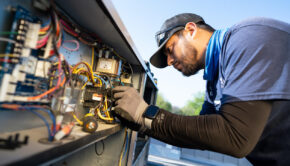Published on September 7th, 2018 | by admin
0The Basics of Horizontal Directional Drilling Method
One of the fastest growing technology in installing pipes and cables underground is trenchless drilling. It is also known as horizontal directional drilling where minimal disruption is created on the soil above-ground. Many industries use this technology. For the utility industry, installing pipelines through directional drilling method requires using small drilling rigs, smaller bore-hole diameter, and lengths to about hundreds of feet. For large applications of horizontal directional drilling, the drilling rigs are significantly bigger, the hole diameter more extensive, and crossing lengths of over thousands of feet.
Regardless of how small or large the intended application, horizontal drilling is a beneficial method when open excavation is not a practical solution. Laying pipework using directional drilling includes three phases:
- The rig drills a small pilot hole through a directional path from one point of the surface to another.
- The small pilot hole is enlarged to allow the pipeline to go through.
- Pipes are pulled through the hole, creating a continuous line of underground pipework where only the starting and end points are exposed.
This method is suitable regardless of the soil condition or obstacles present above and below ground. Directional drilling also has the advantage of crossing through rivers, streams, rail tracks, and roads with minimal disruption to the landscape.
Equipment used in horizontal directional drilling
Since the directional drilling method applies to large and small projects, there is varying equipment used by horizontal directional drilling companies specific to the condition and application requirement. For large-scale directional drilling, the rig should have at most, a pullback or thrust of 600 tonnes. Large-scale projects also require the use of:
- Multiple pumps
- Hoses
- Mud reclaimer
- Excavator
All these additional tools help in supplying drilling fluid into the drilling stem. Depending on the type of surface, different drilling heads are also available to work through rock and soil. For example, a mud-motor is suitable in rocky surfaces.
Aside from large-scale drilling equipment, there are portable types of drilling equipment used for small-scale projects such as connecting the water pipeline from home construction to a shared water line.
Why use horizontal directional drilling?
There are many limitations to open-cut methods of pipe installation. With directional drilling, you are not limited regardless if there are roads, houses, buildings, and rivers blocking the area where pipes are to be laid. In addition to this, the cost of trenchless drilling is significantly lower than open-cut methods.
Aside from the benefit of easier installation and less disruption to the surrounding areas, directional drilling has a few other notable benefits concerning the environment such as:
- It prevents the contamination of groundwater because you are drilling a hole through a predetermined path which limits contact with groundwater sources.
- It prevents damage to rock formations underneath and in the surrounding areas.
- It does not disrupt or damage any landscapes or fragile ecosystem existing around the work area.
Directional drilling is a safer method for workers as well. Similarly, it benefits the contracting party because work is done efficiently and in less time. Indeed, directional drilling is the method of choice when it comes to underground pipework and cable installations.














